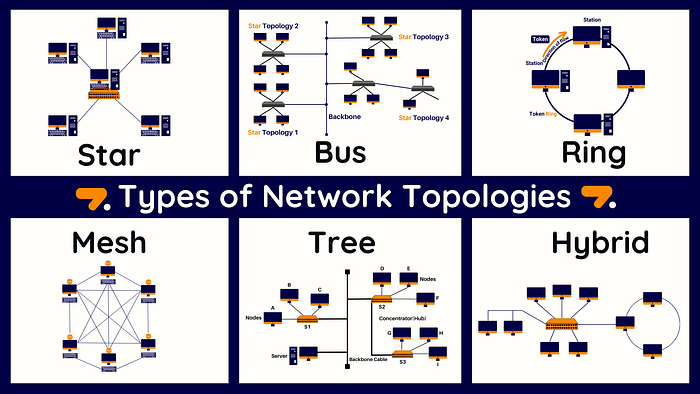Introduction
Network administrators can find faults, troubleshoot problems, and allocate resources more easily with a clearly defined network topology. Diagrams can depict both logical and physical layouts, making them a valuable tool for diagnosing network problems.

Types of Network Topologies
Bus Topology
Definition
Each workstation is connected to the main central cable in series when using a bus topology. It is perfect for small networks due to its straightforward linear layout and economical nature. Bus topology is a network type in which every computer and network device is connected to a single cable.
Advantages of Bus Topology
- Requires only one backbone cable and N drop lines for N devices.
- Uses coaxial or twisted pair cables supporting up to 10 Mbps.
- Cost-effective for small networks.
- Familiar technology with well-known installation and troubleshooting techniques.
- CSMA is a common method used.
Disadvantages of Bus Topology
- Requires a lot of cabling despite being simple.
- A single cable failure causes the entire network to crash.
- Heavy traffic increases collisions, requiring protocols like CSMA/CD.
- Adding new devices slows the network.
- Low security.
Examples
- Ethernet LAN with coaxial or twisted pair cables.
- Cable television networks.
Ring Topology
Definition
Network devices are cabled together in a ring, with the last device connected to the first. Each device connects to two neighboring devices, forming a continuous loop.
Operations of Ring Topology
- Uses a monitor station to manage operations.
- Data is transmitted only when the station holds the token.
- Token is released after data transmission (early or delayed release).
- Data flows unidirectionally or bidirectionally (dual ring topology).
Advantages of Ring Topology
- High-speed data transmission.
- Minimal collision probability.
- Cost-effective installation and expansion.
Disadvantages of Ring Topology
- The failure of one node affects the entire network.
- Troubleshooting is challenging.
- Adding or removing stations disrupts the network.
- Less secure.
Examples
- Token Ring networks.
- Office networks with a circular connection.
Star Topology
Definition
All devices are connected to a single hub through cables. The hub acts as the central node, which may be passive or active (intelligent).
Advantages of Star Topology
- Easy setup with N cables for N devices.
- Robust: one link failure doesn’t affect the others.
- Simplifies fault identification and isolation.
- Cost-effective with inexpensive coaxial cables.
Disadvantages of Star Topology
- Reliance on the hub; failure crashes the entire network.
- High installation cost.
- Performance depends on the hub.
Examples
- Office LANs with a central hub.
- Wireless networks with access points.
Mesh Topology
Definition
Nodes are interconnected, providing multiple routes between network points. Fully meshed networks connect all nodes, while partially meshed networks have fewer interconnections.
Advantages of Mesh Topology
- High-speed communication between nodes.
- Robust and fault-tolerant.
- Easy fault diagnosis.
- Reliable, with secure and private data transmission.
Disadvantages of Mesh Topology
- Difficult installation and configuration.
- High cable costs, suitable for fewer devices.
- Expensive maintenance.
Examples
- Internet backbone with interconnected ISPs.
- Military communication systems.
- Aircraft navigation systems.
Conclusion
Network topologies aid in resource allocation, fault identification, and troubleshooting for administrators. Mesh, ring, bus, and star topologies are among the various types. Mesh topology improves network resilience, bus topology links workstations to central cables, star topology links nodes to hubs, and ring topology links devices.


